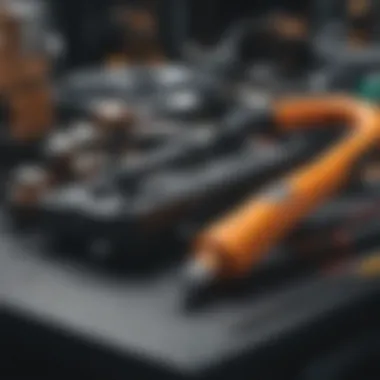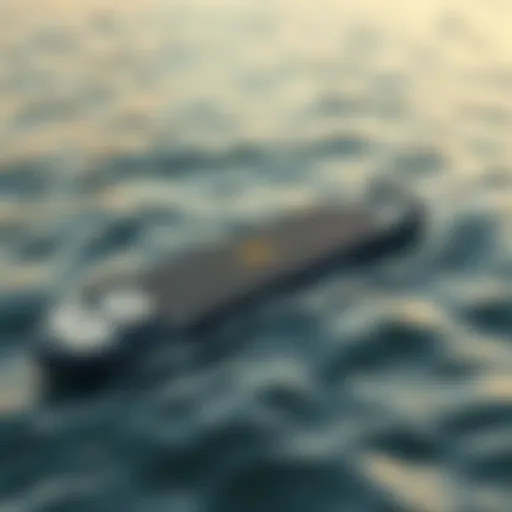How to Build Your Own Efoil: Step-by-Step Guide


Intro
Crafting your own efoil is not merely a hobby; it’s more akin to an exhilarating journey into the world of water sports. With the right blend of skills, components, and a dash of creativity, anyone can embark on this endeavor. Whether you are a seasoned kiteboarder looking to elevate your experience or a first-timer curious about the mechanics of electric hydrofoils, understanding the process is crucial. This guide serves as a roadmap, leading you through every phase of building your own efoil.
While the thrill of gliding across the water is undeniable, safety cannot be overlooked. Each section of this article aims to provide not only technical insight but also practical safety tips. Our in-depth approach ensures that both veterans and rookies find valuable information relevant to their skill level and interests.
To help you navigate your efoil construction journey with ease, we’ll also explore customization options that can enhance performance, making for a truly personalized ride. By the end of this guide, you will not just understand how to build an efoil, but also foster a new appreciation for the craft behind it.
Preamble to Efoils
The world of watersports has seen countless innovations over the years, but few have captured the imagination like efoils. These remarkable contraptions bridge the gap between surfing and aviation, offering a unique riding experience that elevates the thrill of gliding across water. In this introduction, we’ll explore the essence of efoils, outlining their significance in modern marine recreation, and emphasizing the variety of experiences they offer to enthusiasts.
An efoil is essentially a surfboard equipped with a hydrofoil and electric propulsion system that allows riders to soar above the surface of the water. Unlike traditional surfing or kiteboarding, efoiling provides an effortless glide that can be enjoyed even in less than ideal wind conditions. It opens up a whole new dimension for adventure seekers, making it an appealing choice for both novice and seasoned riders alike.
The Appeal of Efoiling
Efoiling is not just a trend; it’s a culmination of technology and a love for the water. Imagine slicing through the waves, rising above them, with nothing but the sound of gliding as your backdrop. The allure of efoiling comes from its ability to provide an exhilarating experience while also being accessible to a diverse group of individuals.
- Versatility: Unlike traditional boards, efoils can be used in a myriad of water conditions. Whether you seek calm lakes or open ocean, efoiling adapts to your environment. The versatility promotes an open sea of possibilities that can cater to any adventurous spirit.
- Simplicity in Learning: While the mechanics behind an efoil may seem complex, the learning curve is surprisingly gentle. Many find that after a brief tutorial, they can balance, steer, and enjoy their ride with ease. This feature attracts kiteboarders and watersport enthusiasts who might be looking for something new to try without getting overwhelmed.
- Environmental Awareness: With the rising focus on eco-friendly activities, efoiling offers a relatively low-impact way to enjoy water sports. The use of electric motors eliminates the need for gas-powered vessels, appealing to those who are mindful of the environment.
“Efoiling isn't just about the ride; it's about connecting with nature and enjoying the tranquility of the water in a sustainable way.”
- Customization Opportunities: For those who enjoy tinkering, the world of efoiling offers endless opportunities for customization. From designing your own boards to adjusting the propulsion system for improved performance, the scope to personalize makes the journey exciting and deeply rewarding.
As we embark on this comprehensive guide, let’s delve deeper into the mechanics and foundational components of efoils, paving the way for you to build and refine your own custom experience.
Understanding the Basics of Efoil Mechanics
Understanding how efoils work is crucial for any aspiring builder. The mechanics behind the efoil not only determine its performance but also its safety and maintainability. A solid grasp of these basics can lead one to make informed decisions during the building process, ultimately contributing to a more enjoyable and efficient ride.
Key Components of an Efoil
Foil
The foil is arguably the most important part of an efoil. It's responsible for generating lift, which allows the board to rise above the water, creating that magical sensation of flying over the surface.
Notably, different foil designs specifically cater to various riding styles and conditions. For instance, larger foils can lift heavier riders and maintain stability at slower speeds, making them ideal for beginners. Conversely, smaller foils are best suited for experienced efoilers who seek speed and maneuverability. One unique feature of foils is their adjustable wings—some come with options for adjustments, allowing riders to customize their experience.However, a larger foil will affect maneuverability, which is something to keep in mind.
Board
The board is your platform for the ride. It must be lightweight yet durable, generally constructed from materials like foam or fiberglass. The design of the board can greatly influence comfort, posture, and control. A wider board provides better balance and is typically more stable, while a narrower board can offer heightened performance and agility.
An additional consideration is the shape—some boards come with a concaved or flat bottom, affecting turning ability and speed. The ongoing use of the board can lead to wear, so choosing quality materials is essential for longevity.
Motor
The motor is what provides the necessary thrust to get you up and flying. Most efoils use brushless motors, known for their efficiency and minimal maintenance needs. These motors are generally quiet, which is great for not disturbing nature while you're cruising along.
The size and power of the motor may vary; larger motors can propel heavier riders and provide faster speeds, but they may consume more power, potentially reducing flight time. It’s essential to match the motor's capabilities with the board and foil to achieve a harmonious setup.
Batteries
Batteries serve as the backbone of the efoil’s power system. Lithium-ion batteries are common due to their lightweight and high energy density, which means they are able to store a significant amount of power without weighing you down too much.
Selecting the right battery also affects how long you can ride. High-capacity batteries will give you extended time on the water but can add to the overall weight of the efoil. One standout option is a removable battery pack, offering flexibility for charging. Just be careful with battery maintenance; overcharging and discharging can lead to performance issues.
How Efoils Work
Efoils utilize a combination of electrical components to operate seamlessly. When you activate the motor, it spins the propeller, which creates a thrust that pushes the board forward. As speed increases, the foil generates lift beneath the water.
The relationship between the speed, the angle, and the water flow is critical. Too steep an angle can cause drag, while too shallow can lead to a loss of lift. The balance of these mechanics is what allows skilled riders to glide smoothly across the water.
Once all components work in harmony, efoiling becomes an exhilarating experience. By understanding these fundamentals, builders can create an efoil that’s not only tailored to their preferences but also optimized for performance.
"Knowledge of the mechanics transforms uncertainty into capability. Be informed, be ready."


Design Considerations for Your Efoil
When embarking on the journey of building your own efoil, thoughtful design considerations become the backbone of your project. The way you approach these decisions not only impacts the performance of your efoil but ultimately shapes your riding experience. From the aesthetics of your build to how each component interacts with the water, understanding these elements is crucial. A well-designed efoil can elevate your ride, offering both thrill and stability while forging a lasting bond between you and the water.
Selecting the Right Foil Shape
The foil is the most vital component of your efoil, and selecting the right shape can make all the difference. Foil shapes vary widely, each tailored for specific conditions and styles of riding. Shallow and wide foils can provide increased stability and lift, making them preferable for beginners or those wanting a leisurely pace. Conversely, more tapered designs are geared towards advanced users seeking speed and agility. Consideration of water conditions and intended use is essential:
- For choppy waters: A larger, more robust foil can help maintain lift, while a smaller foil might struggle.
- For flat water racing: A narrow foil shape allows for higher speeds and better tracking.
- Shape factors: Wider wings tend to lift at lower speeds, reducing the learning curve.
Additionally, keep in mind the material used in the foil's construction. Carbon composites might lend strength and rigidity, but at a greater cost, whereas aluminum offers affordability with disappointment in extreme performance. Experimenting with various foil shapes can lead to discovering your personal preference that perfectly complements your riding style.
Choosing Board Dimensions
Your board’s dimensions are equally pivotal in achieving a harmonious balance with your foil. Length, width, and thickness directly influence stability, buoyancy, and control. Wider boards provide a more stable platform for beginners, while narrower boards may suit those looking to enhance maneuverability.
Here are some guidelines for selecting dimensions:
- Length: A longer board generally offers increased speed and stability, best for high-speed rides.
- Width: Wider boards enhance balance but can feel sluggish in sharp turns.
- Thickness: Thicker boards offer more buoyancy, supporting larger riders or heavier setups.
Remember to take your weight and skill level into consideration when determining board size. Make sure it isn’t just about flaunting the latest trend, but what actually fits your needs and performance expectations.
Battery Placements and Choices
A well-thought-out battery choice and placement can greatly influence the performance and balance of your efoil. When it comes to battery selection, the key elements are capacity, weight, and efficiency. Lithium-based batteries, such as lithium-ion or lithium-polymer, are often favored due to their lightweight and high energy density, which can extend your riding time significantly.
- Capacity: Higher capacity batteries enable longer rides; however, they also come with increased weight.
- Weight distribution: Proper placement is crucial; positioning batteries low in the board can lower the center of gravity, maximizing stability.
- Access for charging: Ensure easy access for maintenance and charging without dismantling parts of your efoil.
Placing your battery too far forward or backward can lead to an unbalanced board. Experimenting with placements and securing the right solution will result in an improved riding experience, suited to your preferences.
"A careful approach to the design choices not only makes a more enjoyable efoil but enhances overall performance and longevity."
Step-by-Step Guide to Building Your Efoil
Creating your own efoil is not just about assembling parts; it’s about crafting a personal experience on the water. This section serves as your compass, guiding you through each step with precision. By following these instructions, you harness both the theoretical and practical aspects of efoiling, ensuring safety and performance throughout your journey.
Gathering Necessary Materials
Before you get your hands dirty, gathering the right materials is paramount. You wouldn’t want to start building only to find out you are missing a key component. The materials typically include:
- Foil - This is crucial for lifting the board above water.
- Board - Choose one that complements your style.
- Motor - Opt for something reliable and powerful enough to provide that exhilarating ride.
- Batteries - The powerhouse behind your efoil, select high-capacity lithium batteries to prolong your adventures.
Don’t forget additional items like screws, seals, and your tools. Make a checklist to avoid any last-minute scrambles. Remember, not having the right materials can make the build tedious or, worse, unworkable.
Constructing the Foil
Constructing the foil is a delicate operation that bears significant importance. The design of your foil will directly affect your efoil’s lift, speed, and maneuverability. Here are the main aspects to consider:
- Shape - The shape of your foil dictates how well it lifts above the water. Wider foils offer stability at lower speeds while narrower designs cater to speed aficionados.
- Material - Materials like carbon fiber provide lightweight yet tough options, enhancing both performance and durability.
Follow the specifications meticulously when cutting and assembling the components. A sturdy foil, after all, lays the foundation for an impressive ride.
Assembling the Board
The board is your connection to the efoil experience, so it must be both comfortable and functional. Start by pre-drilling holes for the foil and motor attachments. It’s crucial to ensure everything aligns perfectly.
When attaching the foil to the board, use high-strength adhesive and screws to maintain integrity over rides. Make sure to analyze the weight distribution on the board; it can impact how well your efoil rides. After that, you can sand the edges for a smoother finish, which not only looks good but can improve aerodynamics while riding.
Installing the Motor and Propulsion System
At this juncture, the motor and propulsion system come into play. Installing these components is primarily about fitment and performance:
- Ensure the motor is securely mounted, as vibrations can cause operational issues.
- Position the propeller system carefully, allowing for adequate clearance from the foil.
Checking the alignment is key. Have a friend assist by holding the board while you make adjustments. A misplacement can lead to suboptimal performance or even accidents.


Wiring and Electronic Components Setup
Once the mechanical components are set, shift your focus to the wiring and electronic aspects. This is often where builders get tangled up, pun intended. Start by connecting the battery pack to the motor.
Utilize heat shrink tubing to cover your connections, preventing water ingress that could lead to failures. Here’s an essential tip: make sure all wires are routed properly to avoid snagging while riding. A cluttered setup can lead to frustrating malfunctions on the water.
In sum, take your time during this setup; it can save you headaches later on. The goal is to create a clean, efficient setup that allows your efoil to operate like a dream.
"Building an efoil isn’t just about the tools; it’s also about the patience and precision you bring to the craft."
Equipped with a well-organized plan, your efoil journey can evolve from a mere idea into a heartfelt passion for aquatic adventures.
Safety Precautions During Build and Usage
When it comes to building your own efoil, the excitement can sometimes overshadow the necessity for safety. It is paramount to adopt a prudent approach from the get-go. Not only does this help in safeguarding your own well-being, but it also ensures that the constructed efoil is reliable and minimizes risks when used on water. The stakes can be high, given that you're dealing with electrically powered components and the rapid movements associated with efoiling. Having a solid understanding of safety measures and equipment is non-negotiable.
Safety Gear Recommendations
When embarking on your efoil building journey, prioritizing personal safety is a wise move. Below are essential safety gear recommendations to keep you protected:
- Helmet: This is a no-brainer. A good-quality helmet can save your head in case of unforeseen spills or accidents. Look for one that fits snugly and is rated for water sports.
- Impact Vest: A buoyancy vest not only provides flotation support but can also cushion blows during falls, making it less likely for you to suffer injuries.
- Wetsuit: Although it may not seem like safety gear, a wetsuit helps keep your body warm in cold water, which can be especially important in preventing hypothermia during extended sessions on the water.
- Footwear: Consider non-slip, water-resistant shoes or booties that provide good grip on the board. They help keep your feet safe from sharp objects while also affording better control over your movements.
- Gloves: Wearing gloves can improve grip on the control system, allowing for better management of the efoil, especially if you're dealing with wet components.
All in all, wearing the appropriate gear not only enhances your safety but also helps you feel more confident as you tackle the building process.
Testing Your Efoil Safely
Once your efoil is built, the eagerness to test it can be palpable. However, rushing into the water can lead to accidents and mishaps. Here are some steps to ensure that you test your efoil safely:
- Pick the Right Location: Choose a safe testing area, preferably a calm and shallow water body where you can practice without the fear of steep waves or obstacles.
- Conduct Pre-Test Checks: Before you hit the water, double-check all connections, especially electrical components. Ensure that everything is secure and properly insulated to avoid any short circuits.
- Start Small: Once you’re in the water, don't accelerate full throttle immediately. Begin at a slow speed to get a feel for the board and how it responds.
- Have a Buddy: If possible, have someone accompany you. Not only can a buddy assist in monitoring your safety, but they can help in case any issues arise while you are testing your efoil.
"Safety first, because everything else comes next."
- Know Your Limits: Pay attention to your comfort and skill level; don't push your boundaries too soon. Gradually work your way up to higher speeds and more complex maneuvers as you gain confidence.
By integrating these precautions and best practices into your efoil building and testing regime, you’ll not only increase your safety but enhance your overall experience on the water. Understanding safety is fundamental to enjoying your self-built efoil to its fullest.
Tuning Your Efoil for Optimal Performance
Tuning your efoil is an essential part of ensuring it performs at its best. Think of it like adjusting the strings on a guitar. A little tweak here and there can change the whole experience when you hit the water. Tuning isn't just about speed; it involves finding that sweet spot where pace, responsiveness, and control harmonize. With the right adjustments, you can increase efficiency and ensure a smoother ride, whether you’re carving up waves or gliding along calm waters.
Understanding Performance Variables
Several factors influence the performance of your efoil. They often work together, making some interplay significant. The key elements to consider are:
- Weight Distribution: How weight is spread across your efoil can affect stability and speed. A lower center of gravity often provides better balance, making for a more enjoyable ride.
- Wing Design: The shape and size of the foil wings impact lift and drag. A more extensive wing will lift earlier, which is great for beginners, but it may also create more drag at high speeds.
- Motor Power: The potency of your motor dictates how quickly you can accelerate and how efficiently you can maintain speed. It's like the engine of a car; a more robust engine can lead to better performance, but might also require more careful handling.
- Battery Quality: The battery needs to provide enough energy to sustain the motor without causing delays or interruptions. An underperforming battery could draw you back.
- Environmental Conditions: Wind, wave height, and water currents can all dramatically change performance. Adapting your setup for these variables can lead to much more enjoyable sessions.
"Adjusting for performance is like learning a fine art. It takes time, but the rewards are more than worth the effort."
Adjusting Settings for Speed and Stability
Fine-tuning your efoil requires understanding how to manipulate the various settings for optimal performance. Here are a few adjustments you might consider:
- Changing the Wing Position: Moving the wing forward or backward can alter how your board reacts on the water. A forward position typically provides better speed, but moving it backward may give more stability.
- Adjusting the Propeller Pitch: A steeper pitch can give you more speed but at the cost of power efficiency. Conversely, a flatter pitch may provide better acceleration at lower speeds, especially useful when learning or when the water is choppy.
- Balancing Battery Placement: Placing the battery lower and more centered can enhance stability. However, if reach is your goal, you might want to experiment with shifting it towards the rear. Each option can change how your board feels underfoot.
- Tweaking the Motor Settings: Many motors allow for adjustments to throttle response. A slower response can aid in smoother rides; however, a snappier throttle can be good for tricks and tight maneuvers.
- Testing and Refining: After adjusting your settings, take your efoil out for a ride. Keep track of what works and what doesn’t, as conditions change, you might find the need to make continual refinements. The learning curve can be steep, but it's all part of the adventure.
It’s crucial to have a proactive approach when it comes to tuning. Think of it as a new recipe – tweaking can lead to mastering your efoil riding, ensuring each outing is even more thrilling than the last.
Maintenance Tips for Longevity
When you take the plunge into building your own efoil, creating a beautiful masterpiece is only the beginning of the journey. Ensuring that this labor of love remains in top shape is essential for both safety and enjoyment. With the right maintenance habits, you can significantly extend the lifespan of your efoil and keep it performing at peak efficiency.
Routine Checks and Care
A well-maintained efoil can be the difference between a thrilling ride and a disappointing experience on the water. Here are some fundamental maintenance tips to keep your efoil in shape:
- Inspect the Foil and Board: Regularly check the foil and board for any signs of wear, especially after getting tossed about in choppy water. Look for scratches, dings, and cracks that may affect performance.
- Battery Maintenance: The batteries are the lifeblood of your efoil. Make sure to check connections and clean terminals. Pay special attention to the battery itself, watching for bulging or swelling. Store it in a cool, dry place and follow the manufacturer’s recommendations for charging.
- Motor and Propulsion System: Periodically examine the motor and the propulsion system for any debris that may have gotten caught. This is especially important after rides in grassy areas or shallow waters. A clean motor will function better and longer.
- Electrical Connections: Keep an eagle eye on your wiring. Loose or corroded connections can lead to performance issues. After each outing, ensure connections are secure and, if necessary, apply a little corrosion-resistant spray or lube to protect metal parts from the elements.
- Visual Checks: Do a quick visual inspection before every ride. A moment spent looking for anything out of place can save a lot of headaches later on.


In the end, knowing your efoil inside and out means developing an intuitive relationship with it. Regular checks foster this understanding and create a safe riding experience.
Troubleshooting Common Issues
Even with diligent care, issues can arise. Here’s a rundown of common problems you might encounter and how to address them:
- Reduced Speed: If your efoil feels sluggish, the first suspect is often the battery. Ensure it’s fully charged and check all connections. Also, examine the propeller for any obstructions or wear.
- Unusual Noises: Strange sounds from the motor can indicate a problem. Check for any loose screws or parts. Most importantly, stop using the efoil immediately and troubleshoot to avoid further damage.
- Erratic Handling: If your efoil is not responding well or feels unstable, it might be worth checking the foil level. An uneven setup can lead to handling issues. Also, inspect the trim settings and adjust as necessary.
- Battery Issues: If the battery seems to drain quickly, it might be reaching the end of its lifespan or not charging properly. Monitor charge cycles and replace as needed.
Handling problems as they arise keeps your efoil in optimal working order and prolongs its life. Remember, being proactive is key—don’t wait until a minor issue becomes a major headache.
Customization and Upgrades
Customization is where the heart of your efoil truly lies. Personalizing your setup not only enhances your riding experience but also allows you to tailor the functionality to your individual needs and preferences. It's about making your efoil uniquely yours, ensuring that every ride reflects your riding style, whether that be smooth gliding or adrenaline-pumping speed. The ability to customize extends beyond aesthetics, encompassing important performance upgrades and component modifications that can markedly impact your overall enjoyment on the water.
Upgrading your efoil is equally essential in keeping your setup relevant and capable of keeping up with advancements in technology as well as shifts in your riding aspirations. As the sport evolves, so do the products. New batteries, faster motors, and sleek designs come onto the market regularly. Therefore, ensuring your efoil is adaptable to these advancements not only preserves its value but also maximizes your fun.
Personalizing Your Efoil
The options for personalizing your efoil are practically limitless. Riders can start with something as simple as choosing color schemes, decals, and graphics that reflect their personalities. This can be an excellent way to express individuality while out on the water. However, customization can run deeper than looks.
- Foil Size and Shape: Depending on whether you’re a beginner or an experienced rider, tailoring the size and shape of the foil can make a significant difference. Smaller foils may offer better maneuverability, while larger foils provide more lift for those who want to ride at lower speeds.
- Board Style: The choice between different board shapes—like a beginner-friendly wide design or a streamlined version for racing—can greatly influence the way you experience efoiling. Each style has its own set of advantages based on your skill level and preferences.
- Control System: Customizing the control system, such as the throttle and remote, can change your responsiveness and comfort while riding. Higher sensitivity controls can help experienced riders execute tricks, while more forgiving settings benefit beginners.
- Batteries: Opting for different battery sizes not only affects the run time but also influences weight distribution. Riders looking for longevity should consider larger batteries, while those seeking lightness might go for a compact design.
Customization is fundamentally about marrying form to function, ensuring that every ride is not just a journey across water but an expression of your riding identity.
Future-Proofing with Upgrades
As technology continues to leap forward, the upgrade possibilities for efoils remain abundant. Future-proofing your efoil means making strategic decisions now that will benefit your experience for years to come.
- Battery Technology: Transitioning to the latest in battery technology, like lithium polymer or lithium-ion, can yield lighter and more efficient energy sources. Upgrading yields not just longer ride times but faster recharge periods, giving you more time on the water.
- Motor Upgrades: As motors become more efficient, swapping to a newer, more powerful motor can enhance your ride quality considerably. Higher RPM motors can deliver quicker acceleration—ideal for enthusiastic riders looking for that thrilling boost.
- Software Updates: Many electronic components, such as the ESC (Electronic Speed Control), benefit from periodic software updates. Keeping your firmware up to date ensures you're using the latest features and fixes, making your ride safer and smoother.
- Accessory Add-Ons: Consider adding accessories like GPS for tracking your speed and distance, or even cameras for capturing your adventures. These features enhance the functionality of your efoil, ensuring you maximize its capability.
The key takeaway is to keep an open mind and remain engaged with the efoiling community. Following the latest trends and innovations can inform your upgrade decisions, ensuring your efoil remains at the forefront of excitement and technology.
In the world of efoiling, your journey is as unique as your ride. Making changes that suit your needs not only enhances your experience, it can also lead to discovering entirely new facets of the sport.
Community and Resources for Efoil Builders
Building your own efoil is a challenging yet exhilarating endeavor, and being part of a community can significantly enhance the experience. Engaging with fellow builders creates avenues for sharing knowledge, troubleshooting issues, and sparking creativity. The efoil community, divided across various platforms, offers a wealth of information that can help both novices and seasoned enthusiasts. This section explores the significance of connections and resources available for those embarking on this thrilling journey.
Connecting with Other Builders
When you start building your efoil, connecting with other builders can feel like teaming up with old pals on a wild adventure. Fellow efoilers can provide invaluable insights into the crafting process, from selecting the right materials to fine-tuning performance. It's not just about technical know-how; sharing experiences creates a camaraderie that enriches the entire building process.
- Tips and Tricks: Sharing personal stories about what worked or didn’t can save you time and resources. For instance, if someone struggled with a specific type of motor, learning about their experiences might steer you clear of potential headaches.
- Resource Exchange: Builders often share links to useful manuals or videos. This swapping of information can lead to better understanding and tips that aren't always found in official guides.
Whether through social media or local workshops, these connections sustain motivation and foster a spirit of innovation. If you find a group of enthusiasts who all share the same passion, it can push you to go further than you ever thought possible.
Online Forums and Support Groups
The internet is a treasure chest of knowledge, and active online forums dedicated to efoiling are a crucial resource. Platforms like Reddit and specialized Facebook groups serve as virtual gathering places for builders worldwide. In these spaces, individuals discuss their triumphs and setbacks in a constructive manner, creating an encouraging atmosphere.
- Finding Solutions: When issues arise, posting questions often results in quick fixes. For example, if your efoil isn't achieving the desired speed, someone who's faced a similar problem could provide insights or exact adjustments that transformed their ride.
- Keeping Up-to-Date: Another great perk of these forums is staying informed about the latest trends and technologies in efoiling. Builders frequently post updates on new products, techniques, and events, keeping the community vibrant and dynamic.
"The knowledge shared in these communities often feels like a safety net. You realize you’re not in this alone and that support is always available, just a few clicks away."
Epilogue
Reflecting on the journey to build your own efoil is an essential wrap-up, illuminating the intricate relationship between craftsmanship and exhilaration. While efoiling may initially seem like a complex endeavor, this guide has laid down the stepping stones from understanding basic mechanics to final assembly.
Reflecting on the Efoil Journey
Undertaking the construction of an efoil embodies more than just assembling parts; it's about embracing a new venture that combines creativity with technical skill. Each component selected—from the foils to the battery placement—significantly impacts performance and ride quality. In many ways, building an efoil is akin to piecing together a puzzle, where each piece must not only fit, but also enhance the overall experience. The satisfaction derived from riding a board that you've crafted with your own hands is unmatched. You get to enjoy the results of your hard work, navigating the waters with a sense of pride.
Consider this: every adjustment made, every design choice molded, and every test ride taken contributes to a deeper understanding of the dynamics at play in both the board and the water. This hands-on experience allows builders to become more than mere riders; they evolve into engineers and designers, constantly learning what tweaks work best for them.
Final Thoughts on Custom Builds
As the dust settles on your custom efoil project, let’s delve into the potential of personalization. Tailoring your efoil not only sets you apart from the crowd but opens doors to endless possibilities. Custom builds can involve everything from aesthetic choices—like a slick paint job that reflects your personality—to performance upgrades that enhance speed or battery efficiency. One might prefer a larger board for stability, while another might crave the nimbleness of a more compact design.
The beauty of customization in this realm is that it gives you agency over your ride. There are endless options out there, from quieter motors like the Fliteboard to faster, more powerful alternatives. The key is finding what resonates with your riding style. More over, embracing this path fosters a sense of community among builders, tapping into shared knowledge and experiences to push the boundaries of what’s possible.
In summary, building your own efoil is not just about the end product; it’s a journey filled with learning, experimentation, and exploration. Whether you're an adventurous kiteboarder looking to ride the waves in a new way, or a traveler seeking a new hobby, diving into the world of efoils is a rewarding endeavor that is sure to enrich your life. > "Every ebuilder's journey is unique, much like the efoils they create. Embrace the process, and the ride will follow."
For more insights, consider visiting forums on Reddit or engaging with communities on Facebook where fellow enthusiasts share advice and modifications. The road to building your efoil is as exciting as riding it.















